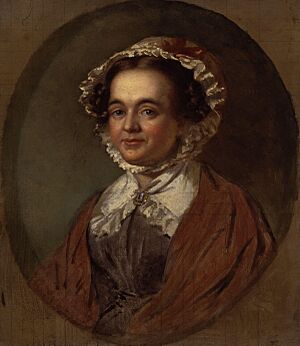Mary Russell Mitford facts for kids
Quick facts for kids
Mary Russell Mitford
|
|
|---|---|

Portrait of Mary Russell Mitford by Benjamin Robert Haydon, 1824
|
|
| Born | 16 December 1787 New Alresford, City of Winchester, England |
| Died | 10 January 1855 (aged 67) Swallowfield, Berkshire, England |
| Occupation | Novelist |
Mary Russell Mitford (born December 16, 1787, died January 10, 1855) was a talented English writer. She wrote essays, novels, poems, and plays. She was born in Alresford, Hampshire.
Mary is most famous for her book Our Village. It's a collection of stories and descriptions about village life and interesting people she met. These stories were based on her own experiences living in Three Mile Cross near Reading, in Berkshire.
Early Life and Education
Mary was the only daughter of George Mitford, a doctor, and Mary Russell. Her mother's family, the Russells, were quite important. Mary grew up near the famous writer Jane Austen and knew her when they were young.
When Mary was ten in 1797, she won her father a huge lottery prize of £20,000! This was a lot of money back then. However, by the 1810s, her family faced money problems. They had lived in big homes in Reading and Grazeley. But after 1819, they had to live on what little money was left from the lottery and what Mary earned from her writing.
Mary's father encouraged her love for interesting people and stories. She took care of both her mother and father until they passed away. She supported them and herself through her writing.
From age 10 to 15, Mary went to a school in Hans Place, London. This school was a successor to the one Jane Austen had attended earlier. Her father hired Frances Rowden to give her extra lessons. Frances Rowden was a published poet. Mary said that her teacher "had a knack of making poetesses of her pupils." Rowden also took Mary to the Theatre Royal, Drury Lane to see plays, especially those starring John Philip Kemble. This made Mary love the theatre.
Mary's Writings
When she was young, Mary wanted to be the greatest English poet. Her first published works were poems. These included Miscellaneous Verses (1810), Christina, the Maid of the South Seas (1811), and Blanche (1813).
Mary also wrote plays. Her play Julian was performed in 1823. Foscari was performed in 1826. Her best play, Rienzi, was very popular and ran for 34 performances in 1828. Another play, Charles the First, was not allowed to be performed in London at first. However, it was later shown at the Surrey Theatre in 1834.
Mary started writing prose because she needed to earn money. This type of writing became her most successful work. The first part of her famous Our Village stories came out as a book in 1824. It had first appeared in The Lady's Magazine five years earlier. More parts of Our Village were published in 1826, 1828, 1830, and 1832. These books were printed many times because they were so popular.
In 1835, she published Belford Regis. This book was another series of stories that described the area around Reading. Her writing about village cricket in Our Village is considered the first important prose written about the game.
Mary's book Recollections of a Literary Life (1852) is a collection of informal talks about her favorite books. Her friends, like Elizabeth Barrett Browning, said that her conversations were even more entertaining than her books. Several books of her letters, published after her death, show that she was a wonderful letter-writer. Her letters offer interesting comments and thoughts on other writers of her time.
Later Life and Passing
Mary Mitford met the famous poet Elizabeth Barrett Browning in 1836. They became very good friends.
Even though Mary's books sold well, her income could not keep up with her father's spending habits. In 1837, she started receiving a special government pension. Five years later, on December 11, 1842, her father passed away. People raised money to pay off his debts, and the extra money helped increase Mary's income.
In 1851, Mary moved from Three Mile Cross to a small cottage in Swallowfield, about three miles away. She lived there for the rest of her life. Mary passed away on January 10, 1855. This was after she was hurt in a carriage accident the previous December. She was buried in the churchyard in Swallowfield.
Legacy
Mary Russell Mitford's life was turned into a radio play in Australia in 1940. It was called Three Mile Cross and was written by Catherine Shepherd.
See also
 In Spanish: Mary Russell Mitford para niños
In Spanish: Mary Russell Mitford para niños

